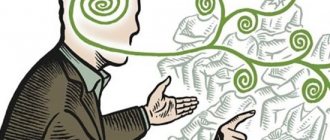What does it mean to be proactive or reactive? You may never have thought about these two concepts, although they are especially relevant in the workplace. These traits actually tend to influence which career path you choose, so we decided to explain them in more detail.
You probably have a friend or acquaintance who is always moving forward, achieving great success at work or in some other aspect of their life. They are constantly looking for opportunities and challenges that push them towards success. You probably also know someone who seems stuck in their job. They have no special aspirations. This is the main difference between a reactive person and an active person.
A proactive person is one who relies only on himself. In any event, he evaluates his actions, his actions and his decisions. The influence of the surrounding world is insignificant for him and is minimized.
A reactive personality , on the contrary, tends to blame any circumstances that get in her way. Even bad weather, even colleagues, even children. There is always some source of interference that prevents you from achieving the result.
What is proactivity and reactivity?
These qualities determine success in absolutely all areas of life; they are two opposing concepts:
- Proactivity can be explained using easy-to-understand synonyms - purposefulness, responsibility, activity, initiative. This is an attitude to life focused on one’s own values and principles, changing circumstances to suit needs, awareness of freedom of choice without infringing on one’s own and others’ rights.
- Reactivity, on the contrary, is characterized by a passive attitude and an unconscious reaction to what is happening, expressed in excessive emotionality and the inability to control what is happening. It is human nature to blame the circumstances around us.
The first trait is characteristic of successful people, and the second - of outsiders. A proactive person finds a way out of any situation. The reactive person can realize himself only in the most favorable conditions, and with the slightest change in circumstances he is unable to do anything and fails.
Proactive Thinking
Proactive people take initiative
Are you still not sure whether you are proactive or reactive? Well, the first thing you should analyze is whether you are taking initiative or not.
Initiative is associated with a skill that is highly valued in the workplace: proactivity.
When you take initiative, you perform certain actions that make you a leader rather than a follower. For example, instead of waiting to find a job, you connect directly with businesses that interest you. You can do this by emailing them cover letters that discuss your interests.
This is a great way to find out whether you are proactive or reactive. Active people rarely wait. They are not afraid to take the reins, try new things and move forward. They experiment and make mistakes instead of waiting for things to happen.
If you are a proactive person, you won't let a closed door, a no, or failure stop you. You are active and keep trying. Whether you believe it or not, this approach opens new doors for you. Although this may not bear fruit immediately, it will help in the long run.
Taking the initiative does not mean being pushy, pushy , or aggressive . This means being aware of your responsibility for ensuring that develop in a certain way.
-Stephen R. Covey-
Proactivity skill
The concept was introduced by the Austrian psychiatrist Viktor Frankl, who wrote the book “Saying YES to Life.” It was published after the author's stay in a concentration camp. It was this skill that allowed him to withstand all the hardships without losing his inner freedom, convictions, and faith in the meaning of existence.
The skill of proactivity is, in simple words, the conscious ability to choose a reaction to current circumstances. It allows a person to fully realize responsibility for his own destiny and demonstrates common sense in any situation.
Features of the vision board of goals and desires
Principles and Examples of Psychology
Every person can become proactive. The development of this skill is based on a clear understanding of its basic principles:
- Freedom of choice as a response to a stimulus without an emotional reaction.
- A thorough analysis of the implementation of the upcoming task and the prevention of possible problems.
- Conscious responsibility for every step taken towards achieving the goal.
- Make quick decisions in any situation thanks to flexible thinking.
- Constant analysis and improvement of your own behavior.
- The correct formulation of questions that allows you to make predictions, that is, “what if...?”, and possible answers.
Proactivity and equanimity should not be confused. The latter implies the absence of a reaction, while the former also implies successful avoidance of the stimulus. You can understand the difference using a simple example: “in 15 minutes you need to walk 1 kilometer from the intended point A to point B, but it started to rain and the road was practically washed away.”
An unperturbed person will walk calmly, even knowing that he will be late. Jet, seeing the slush, simply won’t go and will say that the rain is to blame. A proactive person will check the weather forecast in advance, wear appropriate shoes, plot a route on a map, meet the designated time, or finish the journey earlier.
Proactivity in life and work
In psychology, there are many tests and exercises that allow you to quickly check the presence of this skill. The simplest one is the question “Who is to blame for the boy tripping over the bench?” Children from three to four years old blame the bench, and those older than six blame the child who did not notice it on the way. It seems, what does this have to do with children? Adults who blame circumstances and others essentially remain immature and not proactive.
Setting goals or objectives and achieving them
It's even easier to understand what we're talking about using the example of a fish seeing bait on a hook. She can swallow it and swim on. This is the freedom of choice to be proactive. The decision is always yours. The less emotion there is, the easier it is to decide what to do. Their absence as an irritant allows you to completely ignore problems, moving further towards your goal.
5 Proactive Thinking Habits
Publications in the media
Reactive psychosis is a mental disorder that occurs as a result of exposure to psychosocial stress and is similar to other psychoses, but its variability, lability and affective intensity are more pronounced.
Etiology . A psychotraumatic situation that has a pronounced stressful effect on almost any person under similar circumstances in a given cultural environment. Classification and clinical picture . All reactive psychoses are characterized by the Jaspers triad: the connection of the disorder with mental trauma according to the time of its occurrence, the reflection of a psychotraumatic situation in the clinical picture of psychosis, recovery after the cessation of exposure to a psychotraumatic situation. In domestic psychiatry, the following forms of reactive psychosis are distinguished: • Hypokinetic affective-psychogenic shock reaction (psychogenic shock) - the sudden development of psychomotor retardation, up to complete immobility (affectogenic stupor). • Hyperkinetic affective-psychogenic shock reaction (psychogenic shock, catastrophe reaction) - acute psychomotor agitation, developing against a background of increasing anxiety and fear. Behavior loses its purpose, movements become chaotic and meaningless. Patients rush about in fear, running somewhere, sometimes towards danger (fugiform reaction). • Hysterical psychoses •• Hysterical twilight stupefaction is a disorder that occurs against the background of an affectively narrowed consciousness and manifests itself as anxiety, emotional instability (unmotivated laughter suddenly gives way to crying), sometimes visual hallucinations, pseudodementia. Ganser's syndrome is one of the variants of the disorder. •• Pseudo-dementia (Wernicke's pseudo-dementia) is a regression of mental activity that imitates dementia. Patients are disoriented, answer the simplest questions absurdly, perform basic tasks with gross errors (for example, when asked to point to the eyes they show their nose, instead of a hand they show a leg, they put shoes on their hands, etc.). But their answers always correspond to the topic of the question posed (for example, they call the color white black, summer - winter, etc.). Speech and writing disorders are observed - agrammatism, omission of letters and words, uneven handwriting. Facial expression - confused with a meaningless smile •• Puerilism - regression of mental activity, characterized by the appearance of childish traits in the speech and behavior of an adult. Patients speak with childish intonations, lisp, lisp, address everyone as “you,” call them “uncles” and “aunts,” willingly play children’s games, are often capricious, pout their lips displeasedly, and cry resentfully. The disorder is characterized by dissociation: along with childish traits in behavior, certain habits of an adult are preserved, for example, the correct manner of lighting matches, smoking •• Delusional fantasy syndrome - delusional ideas of greatness, wealth, invention, developing against the background of an affective-anxious background of mood and reflecting the individual’s desire to repress psychotraumatic experiences •• Feralization syndrome - the collapse of complex mental functions against the background of the affect of fear. The patient's behavior is similar to that of an animal. Patients lose self-care skills, crawl, bark, growl, sniff food and objects, eat with their hands, are aggressive •• Hysterical stupor (psychogenic stupor, pseudocatatonic stupor, emotional stupor, dissociative stupor) - severe psychomotor retardation, accompanied by mutism, severe affective stress. Facial expressions are expressive, reflecting affect (suffering, despair, anger). When reminded of psychological trauma, patients' pulse quickens, tears well up in their eyes, and their eyelids and wings of the nose tremble. • Reactive depression is an acutely developing depressive state characterized by depressed mood, melancholy, psychomotor retardation or agitation, and anxiety. At the height of the development of psychosis, delusions, hallucinations and suicidal tendencies may occur. • Reactive paranoid (psychogenic paranoid) •• Reactive paranoia (psychogenic paranoia) is characterized by the development of interpretative delusions that do not go beyond the framework of a psychotraumatic situation •• Reactive delusional psychosis (external environment paranoid, situational paranoid) is characterized by the development of persecutory delusions against a background of severe anxiety and fear, influences, relationships, reflecting the theme of a traumatic situation. Often observed in a forensic investigative situation, wartime, sudden isolation (for example, blockages in mines), a sudden change in the environment (for example, emigration).
Differential diagnosis • Drug intoxication and withdrawal syndrome • Schizophrenia • Mood disorders • Delusional disorder. Treatment • For psychomotor agitation - levomepromazine or chlorpromazine 100-300 mg/day, bromodihydrochlorophenylbenzodiazepine 1.5-3 mg/day • For reactive depression - antidepressants (for example, amitriptyline 150-300 mg/day, imipramine 150-300 mg/day, sertraline 50–100 mg/day once in the morning), tranquilizers (for example, diazepam 5–15 mg/day, bromodihydrochlorophenylbenzodiazepine 1–3 mg/day, medazepam 20–40 mg/day) • For reactive paranoids - antipsychotics (for example, haloperidol 5-15 mg/day, trifluoperazine 5-15 mg/day) • For hysterical psychoses - tranquilizers (for example, diazepam 5-15 mg/day, bromodihydrochlorophenylbenzodiazepine 1-3 mg/day) day, medazepam 20–40 mg/day), neuroleptics (for example, thioridazine, periciazine 40–60 mg/day) • For hysterical stupor - psychostimulants, for example mesocarb 30–40 mg/day. Current and prognosis . Psychosis usually develops within a few hours after the trauma. The duration of psychosis ranges from several hours to several months. With adequate therapy, the prognosis is favorable. The likelihood of a favorable outcome of the disease is indicated by the lability of symptoms, the favorable premorbid state of the patient, the absence of cases of schizophrenia in the family history and the short duration of symptoms (from several hours to several days). Synonyms • Brief psychotic disorder • Psychogenic psychosis
ICD-10 • F23 Acute and transient psychotic disorders
Proactivity books for development
Proactive behavior is constant self-control, increased demands on oneself, the ability to see how to achieve a goal, anticipating or quickly finding a way out of a problem situation. The following books, which are popular with both ordinary readers and managers, can help you develop your skills:
- “Be the best version of yourself” D. Waldschmidt.
- “5 skills of proactive thinking” D. Miller.
- “Man in Search of Meaning” V. Frankl.
- “The 7 Habits of Highly Effective People by S. Covey.
The main thing is not just to study what is written, but to put into practice all the knowledge acquired and work tirelessly to be responsible, purposeful, and proactive.
From an individual point of view
Proactive behavior may be aimed at changing the self (e.g., learning new skills) or the environment (e.g., making suggestions on how to improve care), and can be contrasted with both passive and reactive behavior. There are a number of different task- and organization-specific tasks that can be seen as proactive, such as seeking feedback, making suggestions for improvement, or whistleblowing (reporting wrongdoing in your organization), as well as more self-directed activities, such as managing your career (for example, by taking the initiative to attend training that may be useful in your future job).










